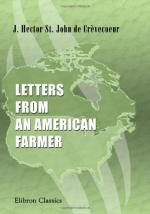The seed is by that time committed to the ground; there is nothing very material to do at home, and this additional quantity of honey enables me to be more generous to my home bees, and my wife to make a due quantity of mead. The reason, Sir, that you found mine better than that of others is, that she puts two gallons of brandy in each barrel, which ripens it, and takes off that sweet, luscious taste, which it is apt to retain a long time. If we find anywhere in the woods (no matter on whose land) what is called a bee-tree, we must mark it; in the fall of the year when we propose to cut it down, our duty is to inform the proprietor of the land, who is entitled to half the contents; if this is not complied with we are exposed to an action of trespass, as well as he who should go and cut down a bee-tree which he had neither found out nor marked.
We have twice a year the pleasure of catching pigeons, whose numbers are sometimes so astonishing as to obscure the sun in their flight. Where is it that they hatch? for such multitudes must require an immense quantity of food. I fancy they breed toward the plains of Ohio, and those about lake Michigan, which abound in wild oats; though I have never killed any that had that grain in their craws. In one of them, last year, I found some undigested rice. Now the nearest rice fields from where I live must be at least 560 miles; and either their digestion must be suspended while they are flying, or else they must fly with the celerity of the wind. We catch them with a net extended on the ground, to which they are allured by what we call tame wild pigeons, made blind, and fastened to a long string; his short flights, and his repeated calls, never fail to bring them down. The greatest number I ever catched was fourteen dozen, though much larger quantities have often been trapped. I have frequently seen them at the market so cheap, that for a penny you might have as many as you could carry away; and yet from the extreme cheapness you must not conclude, that they are but an ordinary food; on the contrary, I think they are excellent. Every farmer has a tame wild pigeon in a cage at his door all the year round, in order to be ready whenever the season comes for catching them.




